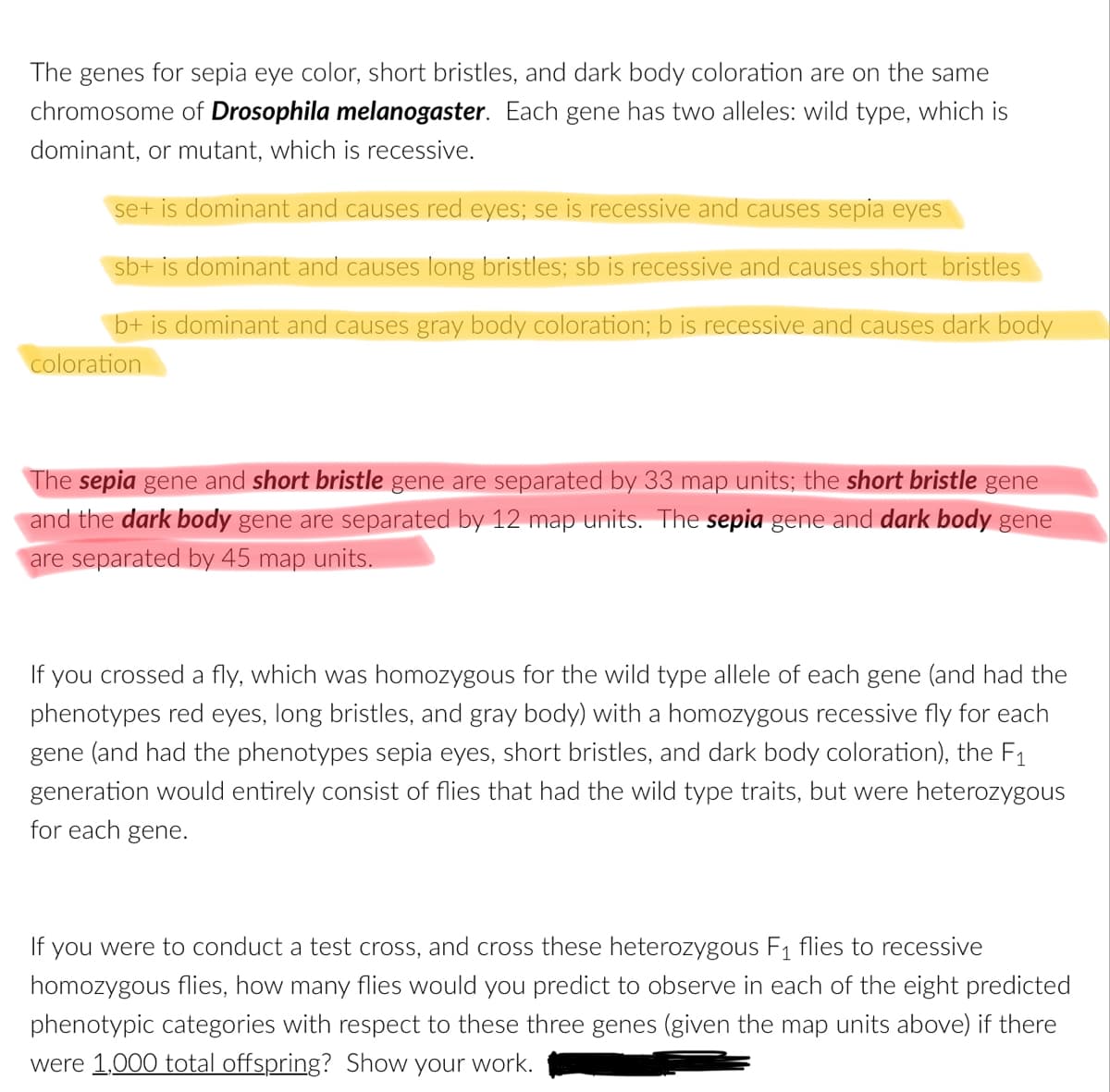se+ is dominant and causes red eyes; se is recessive and causes sepia eyes sb+ is dominant and causes long bristles; sb is recessive and causes short bristles b+ is dominant and causes gray body coloration; b is recessive and causes dark body coloration
se+ is dominant and causes red eyes; se is recessive and causes sepia eyes sb+ is dominant and causes long bristles; sb is recessive and causes short bristles b+ is dominant and causes gray body coloration; b is recessive and causes dark body coloration
Human Anatomy & Physiology (11th Edition)
11th Edition
ISBN:9780134580999
Author:Elaine N. Marieb, Katja N. Hoehn
Publisher:Elaine N. Marieb, Katja N. Hoehn
Chapter1: The Human Body: An Orientation
Section: Chapter Questions
Problem 1RQ: The correct sequence of levels forming the structural hierarchy is A. (a) organ, organ system,...
Related questions
Topic Video
Question

Transcribed Image Text:The genes for sepia eye color, short bristles, and dark body coloration are on the same
chromosome of Drosophila melanogaster. Each gene has two alleles: wild type, which is
dominant, or mutant, which is recessive.
se+ is dominant and causes red eyes; se is recessive and causes sepia eyes
sb+ is dominant and causes long bristles; sb is recessive and causes short bristles
b+ is dominant and causes gray body coloration; b is recessive and causes dark body
coloration
The sepia gene and short bristle gene are separated by 33 map units; the short bristle gene
and the dark body gene are separated by 12 map units. The sepia gene and dark body gene
are separated by 45 map units.
If you crossed a fly, which was homozygous for the wild type allele of each gene (and had the
phenotypes red eyes, long bristles, and gray body) with a homozygous recessive fly for each
gene (and had the phenotypes sepia eyes, short bristles, and dark body coloration), the F₁
generation would entirely consist of flies that had the wild type traits, but were heterozygous
for each gene.
If
you were to conduct a test cross, and cross these heterozygous F₁ flies to recessive
homozygous flies, how many flies would you predict to observe in each of the eight predicted
phenotypic categories with respect to these three genes (given the map units above) if there
were 1,000 total offspring? Show your work.
Expert Solution
This question has been solved!
Explore an expertly crafted, step-by-step solution for a thorough understanding of key concepts.
This is a popular solution!
Trending now
This is a popular solution!
Step by step
Solved in 3 steps with 2 images

Knowledge Booster
Learn more about
Need a deep-dive on the concept behind this application? Look no further. Learn more about this topic, biology and related others by exploring similar questions and additional content below.Recommended textbooks for you

Human Anatomy & Physiology (11th Edition)
Biology
ISBN:
9780134580999
Author:
Elaine N. Marieb, Katja N. Hoehn
Publisher:
PEARSON

Biology 2e
Biology
ISBN:
9781947172517
Author:
Matthew Douglas, Jung Choi, Mary Ann Clark
Publisher:
OpenStax

Anatomy & Physiology
Biology
ISBN:
9781259398629
Author:
McKinley, Michael P., O'loughlin, Valerie Dean, Bidle, Theresa Stouter
Publisher:
Mcgraw Hill Education,

Human Anatomy & Physiology (11th Edition)
Biology
ISBN:
9780134580999
Author:
Elaine N. Marieb, Katja N. Hoehn
Publisher:
PEARSON

Biology 2e
Biology
ISBN:
9781947172517
Author:
Matthew Douglas, Jung Choi, Mary Ann Clark
Publisher:
OpenStax

Anatomy & Physiology
Biology
ISBN:
9781259398629
Author:
McKinley, Michael P., O'loughlin, Valerie Dean, Bidle, Theresa Stouter
Publisher:
Mcgraw Hill Education,

Molecular Biology of the Cell (Sixth Edition)
Biology
ISBN:
9780815344322
Author:
Bruce Alberts, Alexander D. Johnson, Julian Lewis, David Morgan, Martin Raff, Keith Roberts, Peter Walter
Publisher:
W. W. Norton & Company

Laboratory Manual For Human Anatomy & Physiology
Biology
ISBN:
9781260159363
Author:
Martin, Terry R., Prentice-craver, Cynthia
Publisher:
McGraw-Hill Publishing Co.

Inquiry Into Life (16th Edition)
Biology
ISBN:
9781260231700
Author:
Sylvia S. Mader, Michael Windelspecht
Publisher:
McGraw Hill Education